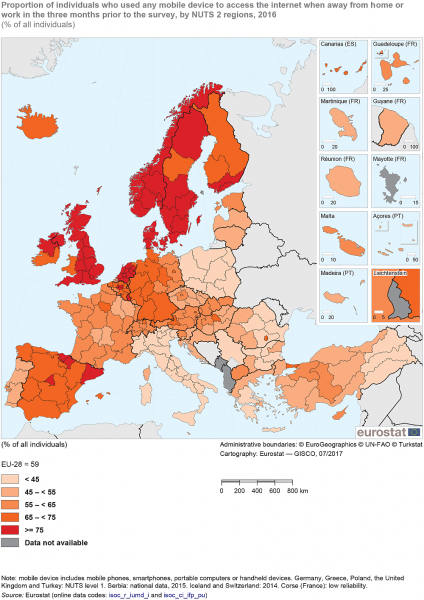Eurostat, the statistical office of the European Union, has published a regional yearbook aiming to provide European statistics collected on regions across a broad range of subjects, for example ICT use. While the yearbook focuses on the EU regions, statistics for Norway and Iceland are also available.
The data in the report are based on NUTS level 2 regions, with Denmark and Finland divided into five regions and Sweden into eight. As for the other Nordic states, Norway is divided into seven regions while Iceland is composed of just one.
Internet use high in all Nordic regions
Regular internet use is relatively high in most EU regions. In a third of the EU regions, the share of the population making regular (daily/weekly) use of the internet reached or surpassed 85 per cent in 2016.
While all regions in the Nordic countries reached this level, Denmark and Norway distinguish themselves with over 90 per cent regular internet users in all regions in 2016.
In 2014 Iceland had the highest share of internet users of all the Nordic countries, but as 2014 is the most up-to-date data available for Iceland, the country is omitted from the other comparisons below.
Copenhagen and Stockholm are the most mobile
The use of mobile devices (such as smart phones) to access the internet away from home or work is increasing. The map below shows that this is particularly common in the Nordic regions.

In almost all regions in Denmark, Norway and Sweden, more than three of four citizens used a smart phone or tablet to access the internet in 2016. The same was true for Finland’s two southernmost regions: the capital region and Etelä-Suomi. (The data refer to the use of mobile devices away from home or work during a period of three months.)
The highest use of mobile devices for internet access (85 per cent or over) was reported in the Danish and Swedish capital regions, as well as in two Dutch and two British regions.
Social media use popular in the Nordics
One of the most common online activities is social networking. More than half of the individuals in the EU-28 used the internet for this activity in 2016, for example using sites such as Facebook and Twitter (during a period of three months).
Again, the Danish and Swedish capital regions top the rankings, here followed by the Danish region of Midtjylland (sharing third place with the Belgian capital region and the British region of Scotland). In these regions, nearly eight of ten used social media in 2016. In Norway, both the capital region (Oslo) and Tröndelag were at the same level.
Nordics top e-government and e-commerce use
The use of e-government and e-commerce is also common in the Nordic countries. For example, a regional comparison of e-government use shows five of the top seven places held by Danish regions, accompanied by the Finnish and Swedish capital city regions, all with at least 86 per cent of individuals having used e-government during the 12 months prior to the 2016 survey.
And, during the same period, almost all Nordic regions had a level of over 70 per cent of their population using e-government services.
As for e-commerce, the regions with the highest shares are spread across Nordic or western EU member states, e.g. all five regions in Denmark, three regions in Sweden, and the capital city region of Finland. (In all these regions, 75 per cent or more of the population reported having made online purchases of goods and services within the 12 months prior to the survey date.) The Norwegian regions, when added to the comparison, are even more prone to using e-commerce than their Nordic neighbours.
About the surveys: The national statistical offices within the EU (as well as EFTA and candidate countries) conduct annual surveys on individuals’ use of computers and the internet (covering 16- to 74-year-olds). The surveys are part of a European project, and the data are reported to Eurostat. In general, the data presented in this overview were collected in the second quarter of the survey year.
The NUTS classification is a regional classification of the EU member states, based on a hierarchy of regions, into three different levels, covering NUTS levels 1, 2 and 3 from larger to smaller areas. While the yearbook focuses on the EU regions, statistics for Norway and Iceland are also available in the database.
Nordregio provides data on the Nordic regions: In the publication State of the Nordic Region 2016, Nordregio reports on the regional developments in the Nordic countries, using statistics, maps and analysis. Among the areas covered are economy, migration, employment, education and energy. Nordregio is an institution within the Nordic Council of Ministers.
Eva Harrie
